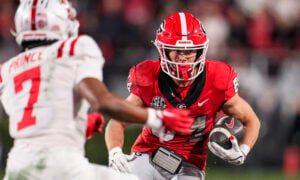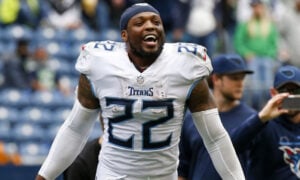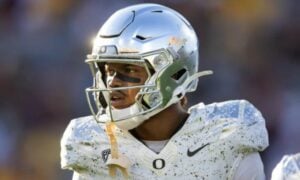Bulletproof Prospect Process: Denzel Mims, WR Baylor
If you are new to the Bulletproof Prospect Process, how it works is we run through a number of metrics and data points that correlate to NFL success, look at player comparisons, and ultimately I give the player a prospect grade.
The possible grades are:
Generational – Extremely rare. I have five active players in my database who have a generational grade.
Potentially Generational – These are players who smashed all of the boxes but didn’t have the requisite draft capital to end up in the generational tier. Odell Beckham and DJ Moore fall into this category.
Bulletproof – This is a grade I give players when I think they have a good chance of becoming a quality NFL producer – players such as Mike Evans and Chris Godwin.
Bullet Resistant – This tier is for players who leave one glaring question mark but otherwise have a fantastic profile. Courtland Sutton getting out produced by Trey Quinn in their final year of college is a good example.
Maybe – The players in this tier often have some element of intrigue but have a few holes in their profile. Think DJ Chark with his lack of college dominance and slight frame.
Bust – This is for players who have prospect profiles that are full of holes. A player who would fit in this category is Dante Pettis.
For wide receivers, there are quite a few things to look at, so let’s dive in!
Draft Capital
When I am looking at wide receiver prospects, I pretty much eliminate anybody who isn’t taken in the first three rounds of the NFL Draft. The hit rate on day-three picks is atrocious. There is plenty of talk of Mims being drafted early enough to matter so I am going to assume that he is drafted at least by the third round.
Size and Athleticism
Something I am always looking for from my wide receiver prospects is adequate size. Height isn’t a prerequisite but width is. I want wide receivers with prototype BMIs. Denzel Mims measured in at 6’3 and 207 pounds for a BMI of 25.9. This is right on the cusp of the 26.0 threshold laid out by Tom Burroughs (@FF_TomB). He found that almost all of the top-12 seasons over the past ten years were by players with a BMI greater than 26.0. I am not going to dock Mims for being 0.1 below that but when we look at his comp list later, you will see where the concern comes into play.
Mims absolutely crushed the Combine. His 4.38-second 40-yard dash at his size resulted in a 115.6 height-adjusted speed score. That puts him in the 96th percentile. The following table shows the closest comparable players to Mims from a size/speed perspective who were drafted in the first three rounds of the NFL draft.

Early Declare
When a college player elects to forego his senior season and enter the NFL draft it immediately increases his odds of hitting at the NFL level. Thanks to the excellent work by Blair Andrews (@AmItheRealBlair) we can see that Mims’s odds take a drastic nosedive when he opted to go back to school last year. You can find the full write-up here.

Breakout Age
Thanks to this super slick chart courtesy of Peter Howard (@pahowdy) we can see that based on breakout age alone, Mims has a decent enough chance at hitting. His 19.9 breakout age would put him at 64.7% if he ends up a first-round pick, 33.3% as a second-rounder, and 22.2% in the third round.

College Production
The single most important factor for me when looking at prospect profiles is college production. I do not look at yards and touchdowns on their own because college offenses are substantially different. One school might be extremely run-heavy while another is exceptionally pass-oriented. A player’s counting stats are often a reflection of the type of offense he played in in college.
Therefore I use Market Share of Receiving Yards. This compares a player’s production within the context of his teams overall passing game. Good players may not always put up eye-opening numbers but they do tend to dominate their own team’s passing work.
Here is a thread where I went through each of the top 25 wide receivers according to Dynasty League Football’s ADP to plot each of their market share of receiving yards in college.
As you are building your rookie draft boards pls keep this in mind
Here is the current top 25 WR's per DLF ADP and their college market share of receiving yards
Pls note, that Tyreek played RB in college (and mostly as a rookie in the NFL as well)
Thread. pic.twitter.com/DxCRqmAoQx
— Bulletproof Beancounter (@DFBeanCounter) February 12, 2020
A quick browse through there should tell you all you need to know about college market share. It matters.
There are two things I am looking for when looking at these graphs. First, I want to see them consistently dominate. Second, I want to see them do it from an early age. Mims played four seasons in college and his sole productive season was as a 19-year-old sophomore.
That is definitely not consistently dominating.

Comparables
At this point, I like to take the size/speed comps and split it into hits and misses. From there, I plot Mims and the hits on one graph and Mims and the misses on another to see how things look. I use two top-24 seasons to weed out the one-hit wonders and when we do that we have a very short list of hits; AJ Green.

Green was selected with the fourth pick in the NFL draft so I think it is safe to say that Mims will not be getting that type of draft capital. That means that as much as they are size/speed comparables, I do not think they are in the same range from a skill standpoint.
Here is Mims and the bust comparables plotted by college market share.

As you can see, outside of that age-19 outburst, Mims had a fairly mediocre-to-poor market share, not unlike most of the players on this list. Stephen Hill and Zay Jones would be the exceptions.
When digging into Zay Jones, you would notice that he had an unnatural 11.1 (eighth percentile) yards per reception at East Carolina. That looks to be a compiler metric and the fact he didn’t breakout until age 20 at a school like that is concerning.
Stephen Hill was drafted well before I was doing this, so I don’t have much insight into his production metrics. But he had an unfathomable 29.3 (99th percentile) college yards per reception.
Competition for targets
One of the biggest things detractors of market share stats fall back on is that it’s hard to produce with quality teammates. Yet as we looked through the market share for each of the top 25 wide receivers per DLF ADP, we found very few non-producers which either meant they weren’t held back by their teammates or THEY were the ones holding back their teammates. Nevertheless, I think a quick browse through the players Mims was competing for targets with is warranted.
At age 18, Mims was held back by KD Cannon and Ishmael Zamora primarily. Neither of them went on to record single reception in the NFL.

Statistics from sports-reference.com.
Then at age 19, Mims shot directly to the top of the receiving yards list. This is a great sign. Unfortunately, I do not see anyone on the list that is even ranked on DLF devy rankings. That is a less good sign, but not necessarily a bad thing. It’s not his fault that he didn’t have high-caliber teammates to beat out for targets.

Statistics from sports-reference.com.
Then in 2018, Mims’s age-20 season, he was usurped atop the totem pole by a college transfer and former running back Jalen Hurd. This is not a very good sign. Hurd had been a running back up until this point but was actually drafted pretty highly in the NFL draft as a third-round pick to play wide receiver for the San Francisco 49ers after the 2018 season. Nevertheless, I would have expected a potential future NFL star, at age 20, (Mims) to not cede to someone playing wide receiver for the first time in his life.

Statistics from sports-reference.com.
Then in 2019 that pesky converted running back was removed from the equation and Mims was propelled back to the top of the receiving board as a 21-year-old senior.

Statistics from sports-reference.com.
So throughout his entire career, Mims played with one possible quality player that walked on to the team to play wide receiver for the first time and tossed Mims aside. Not a great look.
Conclusion
After parsing through the various data points on the Denzel Mims profile, I feel that he is a fairly low-floor player. I will be putting him in my ‘maybe’ category. I think there are definitely things to like, but there are also a lot of questions he left unanswered in college.
Hopefully having all of the data laid out for you will help you come to your own conclusions for the type of player you think he will turn out to be.
- CeeDee Lamb vs Jerry Jeudy: Teammates and Quarterbacks - June 27, 2020
- ADP Trends: Positional Value Gains by Round in Rookie Drafts - April 22, 2020
- Bulletproof Prospect Process: Bryan Edwards, WR South Carolina - April 20, 2020


































































